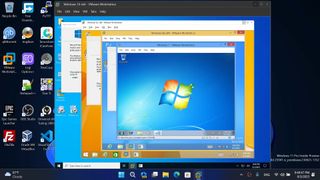Winception: Running Microsoft’s Last Five OSes Simultaneously
Windows 7 running on Windows 8 running on Windows 8.1 running on Windows 10 running on Windows 11

NTDEV has been pushing the limits of the Windowsverse again. The developer’s latest escapade is dubbed “Winception.” We understand the drive to try and run Windows 11, Windows 10, Windows 8.1, Windows 8, and Windows 7 (plus DOS) all at once, but it takes a particular person to pull off such a feat.
According to NTDEV, the ‘nested virtualization’ demonstration pushes current technology to its limits. The dev’s Twitter/X thread about the nesting provides some insight into the method behind the madness.
If you’ve watched the video, you have probably already noticed that the VMWare Workstation was the virtualization software of choice. Unlike other PC wranglers’ experience, NTDEV says that VMWare worked best for him. For example, NTDEV said Hyper-V would exhibit freezing issues after three layers of nesting. VirtualBox was also a dead-end, at two layers deep.
NTDEV sagely admitted his own experience might vary from that of others, as his system was based around an AMD CPU with a modest 16 GB of system RAM. When asked about the secret of his Wincepton success by Tom’s Hardware editor on Twitter/X, NTDEV again mentioned the CPU, thanking the AMD Ryzen architecture for supporting nested virtualization. He was utilizing a laptop powered by a high-end Ryzen 7 5800HS (Cezanne) processor with eight Zen 3 cores, 16 threads, and a boost clock speed up to 4.4 GHz.
When you have a Winception system with four or five OS layers (depending on where you start your count), things can get pretty slow. In his system’s Windows 7 instance, NTDEV checked CPU usage, expecting it to be relatively high. However, CPU usage was only 15 to 20% within Windows 7. It was the last in line for system resources and definitely couldn’t be described as responsive.



Lastly, it was observed that as you move up the layers of virtualization, everything gets a little more fluid – no surprise there. In the video, NTDEV claims that Windows 10, for example, “works just as fast as the host OS.”
NTDEV managed to grab many headlines in recent months with his Tiny11 and Tiny10 lightweight repackaged Windows OS distributions. The developer’s Winception is almost as exciting but is undoubtedly more of a project that exists solely as a novelty.
Stay On the Cutting Edge: Get the Tom's Hardware Newsletter
Join the experts who read Tom's Hardware for the inside track on enthusiast PC tech news — and have for over 25 years. We'll send breaking news and in-depth reviews of CPUs, GPUs, AI, maker hardware and more straight to your inbox.

Mark Tyson is a Freelance News Writer at Tom's Hardware US. He enjoys covering the full breadth of PC tech; from business and semiconductor design to products approaching the edge of reason.
Most Popular






